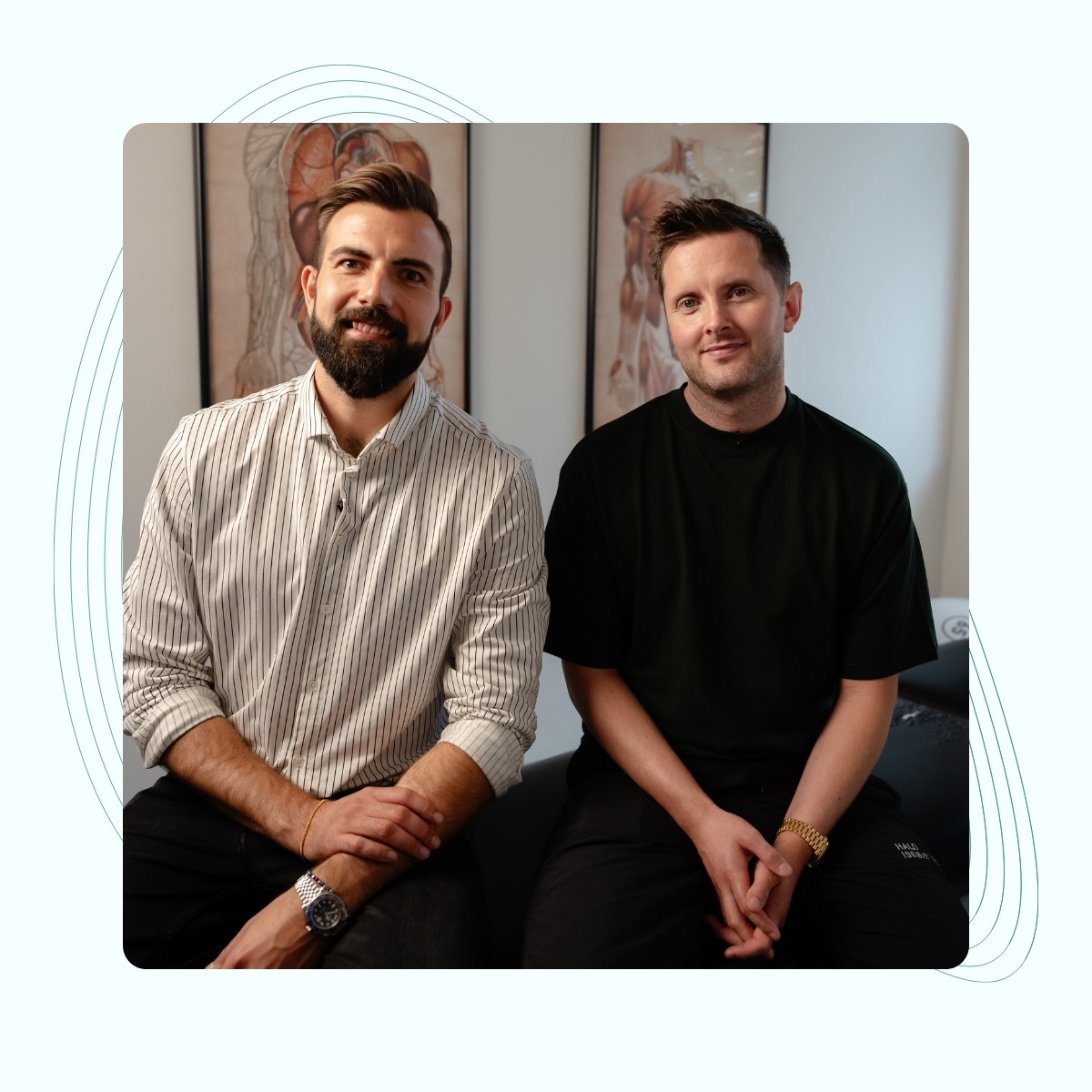We treat
Frozen shoulder
Learn more about frozen shoulder and its pain
What is a “frozen shoulder”?
Frozen shoulder is a term that refers to inflammation of the shoulder joint (glenohumeral joint), which is the joint between the shoulder blade and the upper arm bone. The inflammation affects the joint capsule, causing it to swell, tighten around the shoulder joint and eventually stick to the bones in the joint. When inflammation occurs in the shoulder joint, it can result in pain and reduced mobility.
This happens because the inflammation affects the joint capsule, which is the tissue that passively holds the shoulder blade and upper arm bone together and in place. The joint capsule thus has the task of limiting the mobility of the shoulder, so that you do not cause damage to the surrounding tissue by moving too far. If the joint capsule swells up due to inflammation, mobility is reduced, and pain occurs when you move the arm to extreme positions.
Jump to section [Vis]
Who is affected by frozen shoulder?
Typically, people between the ages of 40 and 60 develop frozen shoulder. Women are affected more frequently than men.
Of those who develop a frozen shoulder, 6-17% will also experience problems with the other shoulder.
This typically happens within 5 years after the first shoulder starts to cause problems and typically only when it no longer causes problems.
Studies indicate that patients with diabetes, thyroid disease, heart and lung problems, or Parkinson’s disease have an increased tendency to develop a frozen shoulder. A frozen shoulder is seen 5 times more frequently in people with diabetes.
There is no difference between type 1 and type 2 diabetes. (Dias, Cutts, Massoud; 2005).
There is also a tendency for people with sedentary jobs to be more predisposed than others.

Causes of frozen shoulder scientific reasons
The diagnosis of frozen shoulder can be divided into 2 – a primary (idiopathic) and a secondary frozen shoulder, which divides the known causes of a frozen shoulder. A primary frozen shoulder can be caused by other systemic problems in the body, such as diabetes and metabolic problems.
In diabetes, the body attacks parts of its own cells, which creates inflammation in the body’s tissues.
Here, the tissue in the shoulder joint capsule can be severely affected, which over a long period of time causes a shrinking of the joint capsule, which makes movement and vascularization (blood flow) of the joint difficult.
A secondary frozen shoulder occurs after previous trauma or problems in the shoulder, resulting in scar tissue. These include surgery, prolonged immobilization after a rotator cuff injury, subacromial impingement (shoulder impingement – pinched nerve syndrome), injury to the biceps tendon or other forms of tendonitis around the shoulder. (Chan, Pua, How How; 2017).
The hip flexor originates at the top of the front of the back, extends across the pelvis and attaches to the inside of the thigh bone. The hip flexor receives nerve supply from the lowest thoracic vertebra and the two upper lumbar vertebrae.
The connective tissue covering the hip flexor has an anatomical connection to the kidneys and the respiratory muscle itself.
The blood supply to the hip flexor comes directly from the main artery itself.
Osteopathic causes of frozen shoulder
From an osteopathic perspective, the shoulder is a very interesting joint, understood in the sense that many areas of the body can contribute to a frozen shoulder.
For a joint to function optimally, it must receive good nerve and blood supply. These factors are dependent on the body as a whole being able to move optimally.
Neurological causes of frozen shoulder
The primary nerve supply to the shoulder joint is called the axillary nerve. This nerve originates in the lower part of the neck and has several areas in its course down the back of the shoulder where it can become compressed. Compression of a nerve reduces its ability to relay the axon’s signal from the spinal cord, which can disrupt the shoulder joint.
The nerve has 2 places in particular where it is exposed to compression – behind the collarbone and at the back of the shoulder, where it runs out through the quadratus area, which are 3 muscles bordering the inside of the humerus, forming a small square where the nerve passes through.
If you tend to slouch in your back, the area behind the collarbone can become compressed, which can irritate the nerve as it runs towards the shoulder.
Posteriorly, topographic changes occur in the size of the hole through which the axillary nerve runs, as inwardly rotated arms reduce the hole through which the nerve runs and can thus again create compression around the nerve.
Accessory nerve
Also worth mentioning is the accessory nerve, which is a nerve that originates from the back of the skull. This nerve is responsible for controlling our large diamond-shaped muscle in the neck – the trapezius muscle. This muscle is responsible for pulling the shoulders back, among other things.
If it is affected in its course from the skull and down the neck, this can contribute to the shoulder falling forward more easily and thus pinching the axillary nerve at the shoulder joint.

Frozen shoulder & vascular (blood supply)
From a vascular perspective, posture also plays a big role. The large subclavian vein, which drains venous blood from the arm, also runs behind the collarbone. With shoulders pulled forward and rotated inward, there is less room for blood to flow back, which can reduce the body’s own way of removing waste products. This reduces the body’s natural healing process and promotes inflammation in the area.
The chest and its organs also play a big role. The shoulder is a joint that rests on the entire ribcage.
The ribs and the mobility of the thoracic spine serve as the origin or attachment point for many of the muscles related to the shoulder joint. A stiff chest can therefore contribute to fatigue of the muscles of the shoulder and contribute to reduced mobility.
Visceral (organ) causes of frozen shoulder
The organs heart and lungs also play a role in frozen shoulder. Both the heart and lungs are attached to the rib cage via our membrane system.
When these membranes become stiff, for example after inflammation in the lungs or sedentary work, this can stiffen the ribs and thereby negatively affect the shoulder.
In addition, there is a neurological (nerve) connection between the nerves in the arm and the nerves to the heart and lungs. This happens through the sympathetic nervous system, which is responsible for the autonomic control of the organs – something we don’t have to think about ourselves. If there is too much sympathetic activity around the heart and lungs, this affects the entire nerve bundle (brachial plexus) in the arm.

Mechanical causes
The pelvis should also be mentioned, as we have an important muscle from the pelvis called the latissimus dorsi muscle. This runs from the pelvis up the front and inside of the upper arm. In a standing position with the arms down by the side, its pure function is to bring the arm around behind the back and internally rotate the arm.
If there is a pelvic tilt, this can cause the latissimus dorsi muscle to tighten, which turns the upper arm inward. And as shown above, this can have some negative consequences for the shoulder.
Diagnosis of frozen shoulder
The diagnosis is made by a doctor or rheumatologist, based on the person’s medical history and an examination of the shoulder.
Frozen shoulder is characterized by reduced mobility in all directions of movement of the shoulder, which is different from other shoulder disorders. External rotation of the shoulder is particularly difficult.
Further investigation such as laboratory tests do not provide a clear answer as to whether it is a frozen shoulder, but can be used to rule out that there are no other pathologies behind the patient’s symptoms. It is possible to examine the joint capsule via ultrasound scanning and MRI scanning, which in the case of a frozen shoulder will show a thickening of the anterior joint capsule and ligaments.
Source: Netdoktor.dk

Frozen shoulder stages
The course of a frozen shoulder is divided into 3 stages. When all 3 stages are over, most people are symptom-free – 10% still have symptoms 4 years after the onset of pain.
-
- Phase 1 – the warm phase. This lasts from 2-6 months and is typically the phase with the most pain. The shoulder begins to stiffen in all directions and pain occurs with activity and rest.
The patient may benefit from pain-relieving techniques.
- Phase 1 – the warm phase. This lasts from 2-6 months and is typically the phase with the most pain. The shoulder begins to stiffen in all directions and pain occurs with activity and rest.
-
- Phase 2 – the frozen phase. This was from 6-12 months. Here the stiffness in the shoulder increases, while the pain typically decreases. The focus is now both on mobility, but also on light maintenance of strength in the shoulder.
-
- Phase 3 – the thawing phase. This lasts from 12-36 months. Here, mobility in the shoulder is regained, while the pain disappears. The focus is on regaining full mobility and restoring full strength and stability around the shoulder.
Frozen shoulder – symptoms
The symptoms can start with sudden onset of severe pain, but can also develop slowly over several months. The pain is primarily localized around the shoulder joint itself, radiating to the upper arm. In severe cases, the pain can go down into the forearm.
In addition, there is a marked reduction in mobility in all directions of movement of the shoulder. External rotation in particular is limited. Mobility is reduced in both active and passive movement.
The condition is often associated with nighttime pain, as it can be difficult to find a pain-free sleeping position.
A frozen shoulder typically affects the non-dominant arm. However, there is a strong tendency for patients with a frozen shoulder to subsequently develop it in the opposite shoulder – this happens in 20-30% of cases.

Frozen shoulder and inflammation
A frozen shoulder is associated with an inflammatory condition in the shoulder joint capsule. When inflamed, the joint capsule first swells up, which compresses the structures in the shoulder joint and causes severe pain in and around the shoulder joint. The patient will tend to avoid extreme positions, as this can further compress the joint capsule.
Inflammation itself is the body’s own way of responding when it needs to repair something. The immune system is responsible for the inflammation, which aims to heal the area of damage.
After an inflammatory condition, there is a risk of scar tissue formation and adhesions, also called adhesion formation, in the joint capsule. In surgical treatment of frozen shoulder, it is these adhesions that one wants to loosen.
Difference between frozen shoulder and shoulder impingement
Distinguishing between a frozen shoulder and impingement can be difficult and is often confused.
-
- Shoulder impingement involves a pinching of the structures that run under the part of the shoulder blade called the acromion. The condition is associated with too little space in this area, which can irritate the supraspinatus muscle and a bursa in the same area. The pain here typically occurs when the arm is extended to the side or forward in front of you, and often when you turn the thumb downward (pouring a glass of water). This is pain associated with active movement.
- In a frozen shoulder, the pain-causing structure is the joint capsule itself inside the shoulder joint, which causes severe restriction of movement in all directions, especially rotation and pain during both active and passive movement.
A major indicator of frozen shoulder is reduced ability to rotate the shoulder – this is tested by placing the elbow bent in front of one’s stomach, then rotating the upper arm from side to side so that the forearm rotates alternately to the right and left. Severely reduced mobility in this plane is an indicator of frozen shoulder, which is to a lesser extent an indicator of impingement.

Why do you get frozen shoulder?
The causes of a frozen shoulder are not fully understood. However, a connection can be seen between various other conditions in the body and previous trauma to the shoulder. These include diabetes, metabolic problems, and Parkinson’s disease.
How long does frozen shoulder last – prognosis?
The prognosis for a frozen shoulder varies from person to person. However, it is a condition that typically involves a longer course. The course is divided into 3 phases, most of which are completed by phase 3 and after 2-3 years. After this, the arm will in most cases function normally again.
Frozen shoulder and sick leave
Whether you should call in sick with a frozen shoulder depends on how bad your symptoms are and what kind of work you do. When you have a frozen shoulder, you should avoid repeatedly extending your arm to extreme positions that cause severe pain, as this can increase the inflammatory process and cause severe pain. If you have a job where this cannot be avoided, you should consider calling in sick until the condition slowly improves.
Frozen shoulder and cancer
There is a link between patients who have had surgery for breast cancer and those who develop a frozen shoulder. The link means that those who have had surgery for breast cancer at the age of 50-59 and who have had a mastectomy (removal of the entire breast) are at increased risk of developing a frozen shoulder. According to the study, the cause increases further with mastectomy with reconstruction. It is therefore beneficial to pay extra attention to a frozen shoulder if you have had a mastectomy, with or without reconstruction, in order to identify a shoulder problem earlier and initiate treatment quickly. (Yang et al.; 2017).
Frozen Shoulder diabetes
There is a clearly increased risk of developing a frozen shoulder in diabetic patients, both in type 1 and type 2 diabetes. The prevalence of frozen shoulder is 5 times higher in patients with diabetes than in people without diabetes. In diabetes, the body attacks parts of its own cells, which creates inflammation in the body’s tissues. Here, the tissue in the shoulder joint capsule can be severely affected, which over a long period of inflammatory state causes shrinkage of the joint capsule, which makes movement and vascularization (blood flow) of the joint difficult.

Frozen shoulder after surgery (postoperative) or after a fall
Previous trauma (falls or crashes on outstretched arms, broken bones, shoulder dislocation) plays a very large role in the development of a frozen shoulder.
After a trauma, such as landing on the side of the arm, the passive structures of the shoulder joint (joint capsule, labrum, ligaments) can be damaged, which can result in scar tissue. Over time, this scar tissue can create inflammation around the shoulder joint, which can cause the joint capsule to shrink.
The nerves to a previously damaged joint are also affected and also play an important role. If increased scar tissue occurs in the shoulder joint, it affects the nerves that control the joint in such a way that the muscles around the joint do not function optimally.
Previous surgeries are also very important. Any surgical procedure causes scar tissue in the shoulder joint, which is a predisposing factor for a frozen shoulder.
Frozen shoulder menopause
When women go through menopause, the risk of developing a frozen shoulder increases. There is a clear correlation. One explanation for this may be that when the body’s natural production of estrogen decreases in women when they go through menopause, it affects all tissues in the body to become stiffer, including the connective tissue in the body. If there is a previous trauma or surgery around the shoulder prior to menopause, you are therefore at increased risk of developing a frozen shoulder.
Frozen shoulder & back and neck pain
The neck plays a central role in the development of a frozen shoulder. There are several explanations for this. First and foremost, there is a neurological explanation, as the nerves to the shoulder joint originate from the skull, neck and upper thoracic spine. A problem around the neck, such as whiplash or increased muscular tension, can reduce the muscles’ ability to control the shoulder joint optimally, which can contribute to increased degeneration of the joint.
A previous back injury can also affect the shoulder.
The thoracic spine and rib cage act as the foundation for the entire shoulder. Reduced flexibility around the thoracic spine can lead to reduced muscle activity in the muscles of the shoulder, which over time leads to increased degeneration.

Frozen shoulder & autoimmune disease
In autoimmune diseases, the body mistakenly considers healthy tissue in the body as dangerous tissue and therefore attacks it via the immune system. In metabolic diseases – both too high and too low metabolism, this can affect our muscles and joints.
Symptoms of this include muscle and joint pain, stiffness, and difficulty lifting your arms above your head.
Treatment of frozen shoulder
With osteopathic treatment it is possible to relieve the discomfort of a frozen shoulder. The treatment is based on, among other things, improving the nerve supply to the area via the neck and thoracic spine, improving blood flow to the area, improving mobility in the chest and organs in the chest, reducing the body’s sympathetic (stress) tension in the arm and relaxing the muscles of the shoulder. It is not possible to remove the frozen shoulder, but there is good evidence that manual treatment of a frozen shoulder provides a shorter prognosis and helps to relieve the pain associated with the condition.
Due to the reduced mobility in the shoulder joint, compensation is often seen elsewhere in the body, typically in the neck. It is important to keep this area mobile and relaxed so that additional tension does not arise elsewhere in the body, which can lead to a longer prognosis.
Prevention & good advice for frozen shoulder
There are different tips for a frozen shoulder, depending on how far along you are in the process. In general, you should keep your shoulder mobile as much as possible without causing pain or worsening the shoulder pain. Repetitive irritation of the joint capsule in extreme positions increases inflammation and should therefore generally be avoided. We usually divide the process into 3 phases, which we will go through below.
Phase 1 – Maintaining mobility
In phase 1, the focus should be on maintaining the mobility you have without irritating the shoulder joint. The neck and thoracic spine should also be kept mobile, so stretching exercises for the neck are a good supplement.
Exercise: Standing bent forward at a table. Let the frozen shoulder hang from the upper body, while the healthy arm supports the table. With the frozen shoulder, you make light circular movements in the range of motion you can, without worsening the pain around the shoulder. Due to the weight of the arm, traction is created in the joint, which relieves the joint. This can be done for 1-2 minutes.
Phase 2 – Beginning muscle activity
In phase 2, you should continue with the mobility training as in phase 1, but slowly start with light isometric exercises (muscle activity without movement) that do not provoke the shoulder. In addition, you should focus on the joints around the shoulder joint itself – the shoulder blades and rib cage should be kept mobile.
Exercise: Standing with a straight back. Pull your shoulder blades together and hold this position for 5 seconds. Then relax for 3 seconds. Repeat this 3 x 12 times.
Phase 3 – Challenge via controlled training
In phase 3, the shoulder begins to be able to move more. It is important here that the shoulder is challenged in all directions of movement, both as movement training, but also strength training of the muscles that have not been used for a long time. This must be done in a controlled manner, as the shoulder may still be fragile.
Exercise: With an elastic band, do inward and outward rotation exercises. The elbow is bent and held close to the body. From here, the arm is rotated inward and outward, respectively, with resistance from an elastic band. Repeat 3 x 12 on each side.

Often related problems
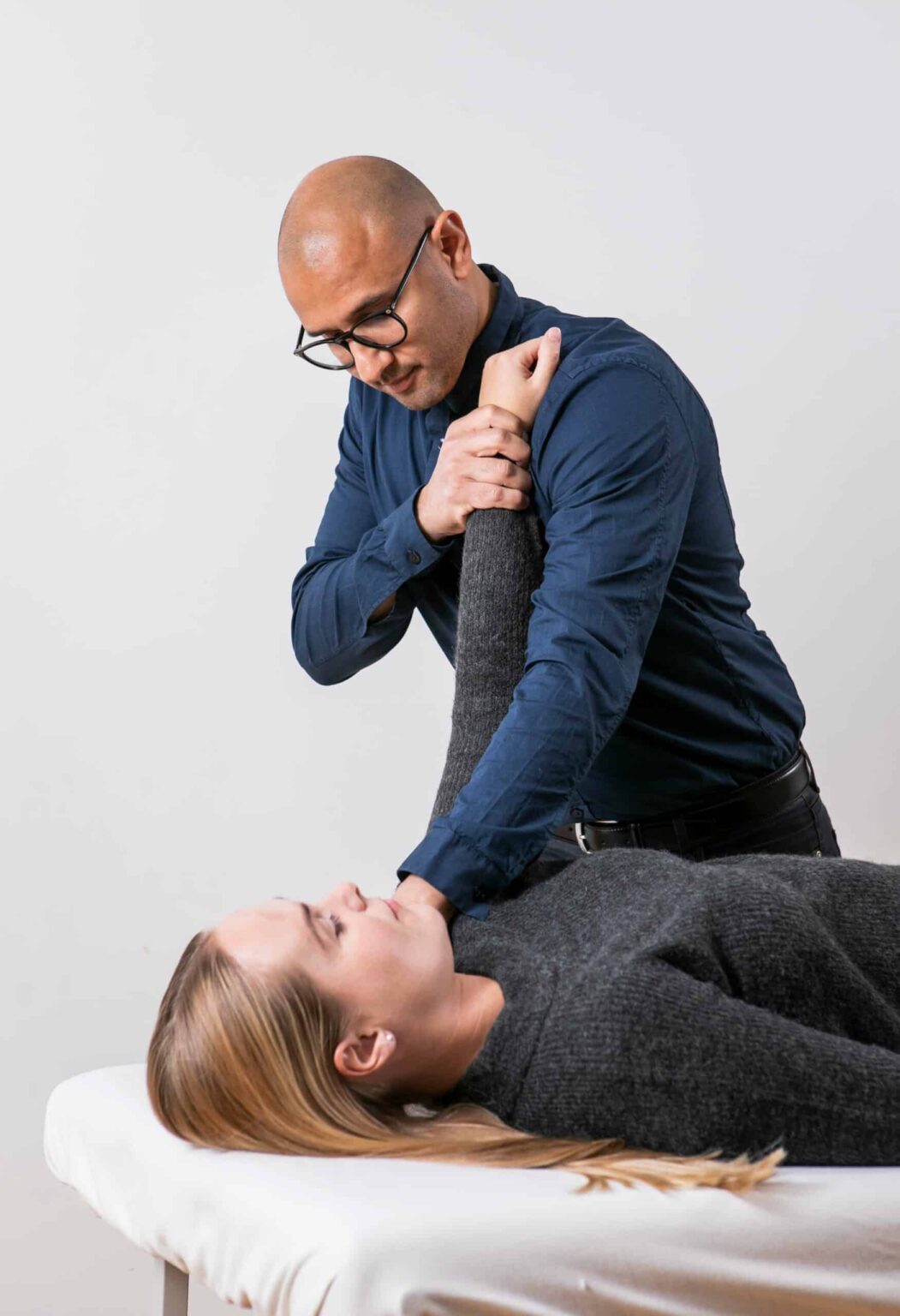
Shoulder dislocation
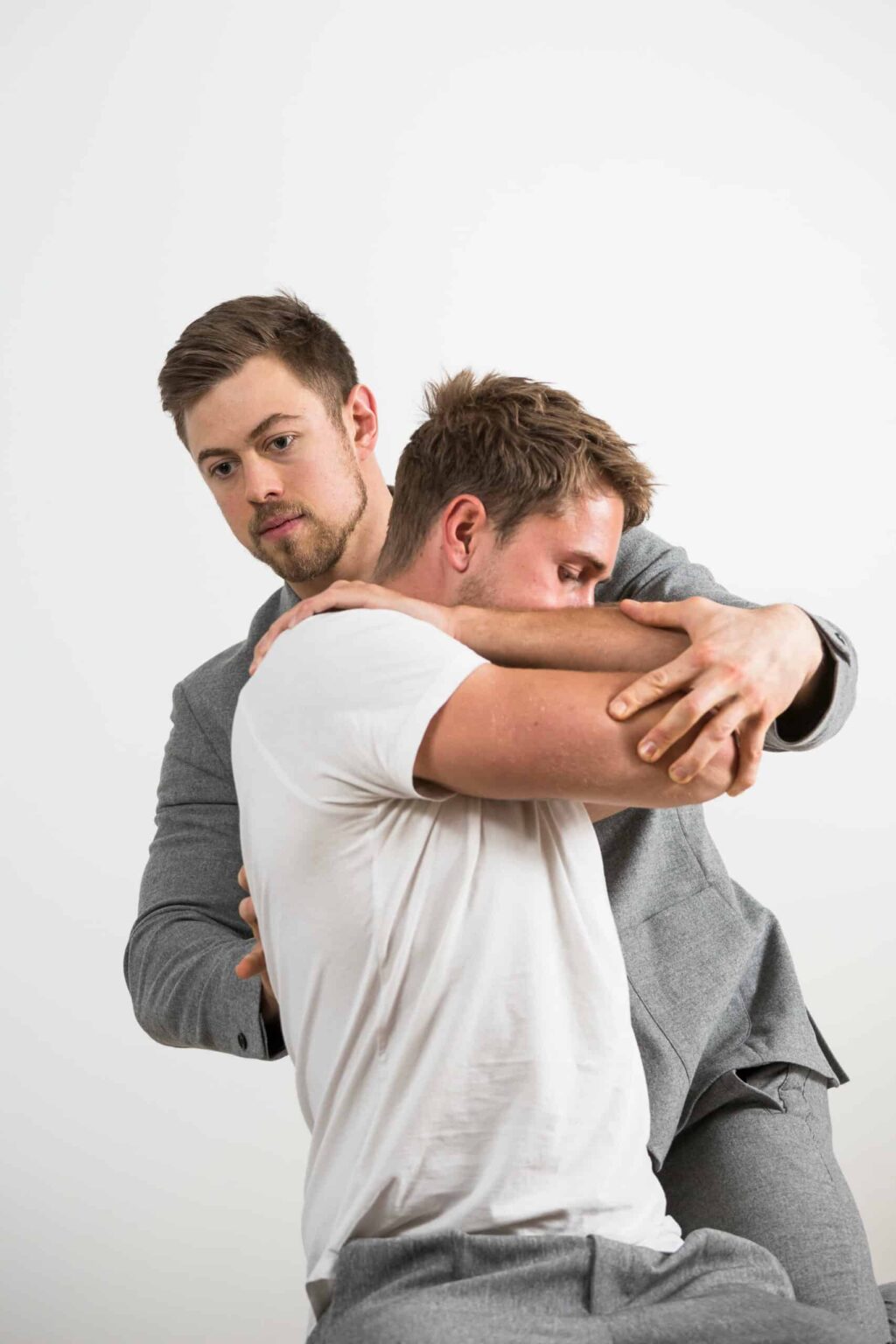
Winged scapula
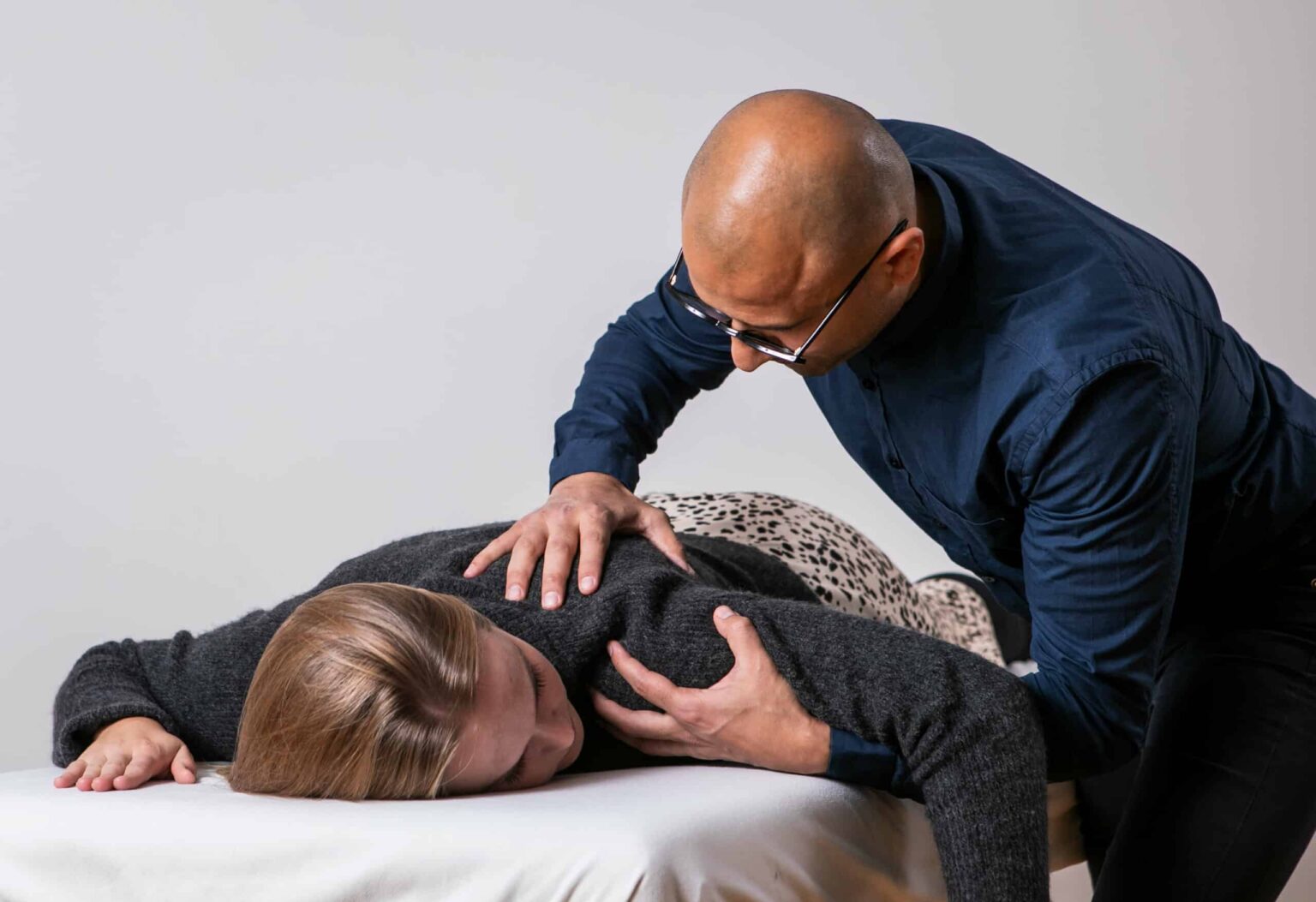
Rotator cuff injuries
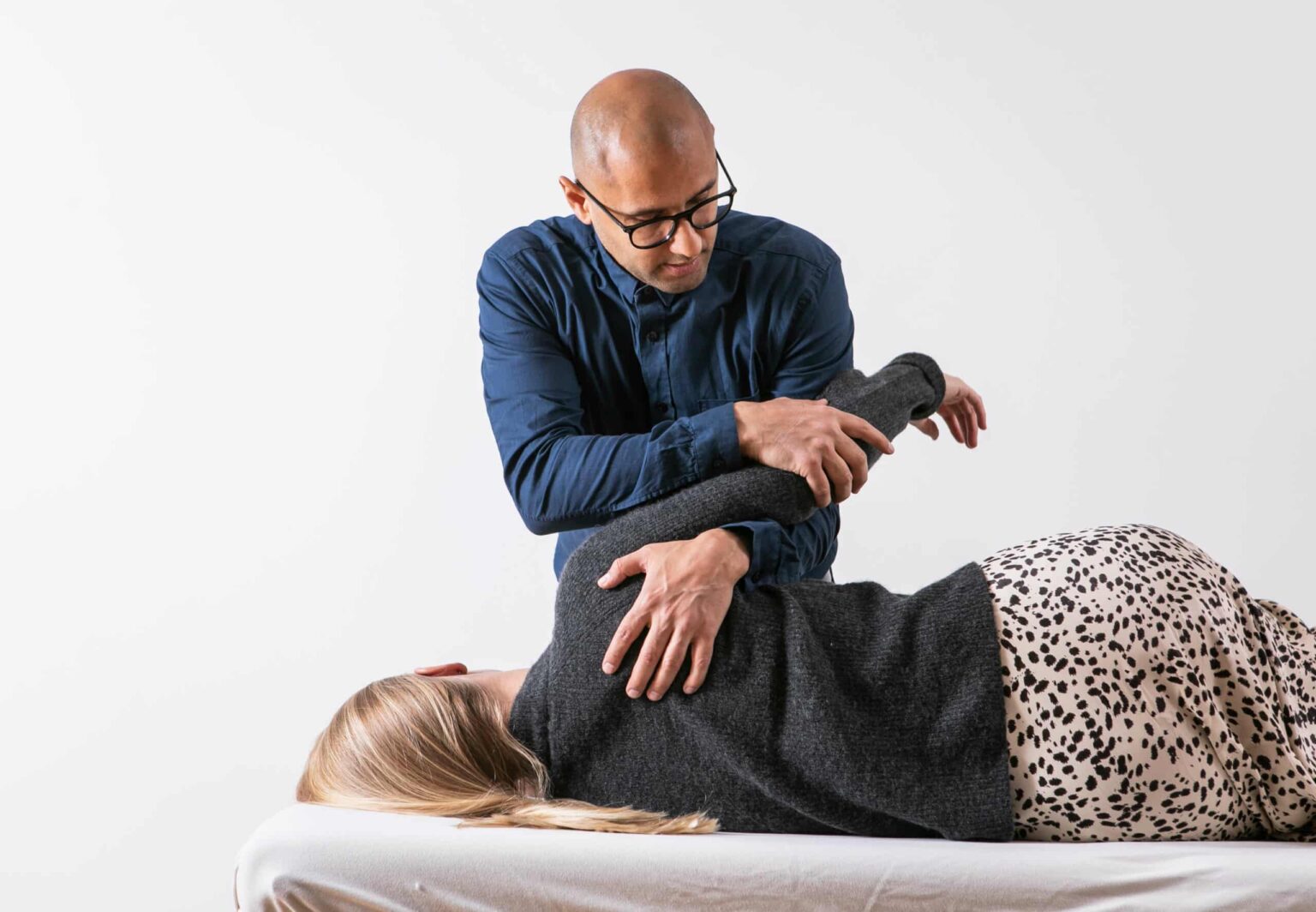
Shoulder pain

Frozen shoulder

